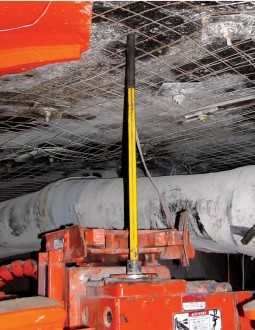Mining Feature: New Drill Bit Isolator Reduces Noise
Tuesday, April 14, 2015

Diagram showing how the drill bit isolator is connected between the drill bit and the drill steel.
An innovation in underground coal mines is significantly reducing the hazardous drilling noise that originates from roof bolting machines during the drilling procedure. After extensive research into the source of this hazardous noise, researchers at the Office of Mine Safety and Health Research (OMSHR) have developed a drill bit isolator--an engineering noise control that addresses the problem of hazardous noise from roof bolting machines and that is now commercially available.
Reducing the source of hazardous noise from roof bolting machines can help reduce noise-induced hearing loss (NIHL) in mine workers who operate these machines and those who work in the vicinity of them. Hearing loss can severely impact a worker's quality of life. Studies conducted by the National Institute for Occupational Safety and Health (NIOSH) indicate that approximately 90% of coal mine workers have hearing loss by retirement age, as compared to 10% of workers that are not overexposed to occupational noise. OMSHR researchers found that using the drill bit isolator during the drilling operation can reduce the noise exposure of the operator by 3-5 decibels, which equates to a 50%-68% reduction in noise.
Operators use roof bolting machines to install roof bolts in the mine's roof or side walls (ribs) to support the strata, which prevents injury to mine workers from roof or rib falls. To install roof bolts, the roof bolting machine operator drills a hole into the strata and installs the roof bolt, repeating this procedure many times during the workday. Noise exposure data collected by both NIOSH and the Mine Safety and Health Administration (MSHA) show that operators of roof bolting machines routinely receive hazardous doses of noise during their work shifts.
OMSHR researchers found that hazardous noise from roof bolting machines is produced by the mechanical vibration of the drill steel that is caused by the interaction of the drill bit with the mine roof strata during drilling. The drill bit isolator was designed to isolate these vibrations and, in turn, reduce the radiated noise. This device consists of an outer and inner steel tube with a rubber layer that separates the tubes, thus avoiding any metal-to-metal contact, which reduces vibration from the drill bit to the drill steel. The drill bit isolator can be used in a drill steel with standard 1-3/8-inch-diameter drill bits. OMSHR collaborated with Corry Rubber Corporation and Kennametal, Inc. to produce this drill bit isolator for commercial use.
Both laboratory and field tests were conducted by OMSHR to test the effectiveness of the drill bit isolator. The field tests were conducted in five underground coal mines throughout the United States, and showed that the drill bit isolator significantly reduces noise generated from a roof bolting machine without interfering with the roof bolting operation.
The new drill bit isolator is currently being marketed and sold to mines in the United States. OMSHR, Corry Rubber, and Kennametal are also working together to test another drill bit isolator, expected to be in production within a year, for drill steels that use 1-inch-diameter drill bits.

A drill bit isolator in use as a roof bolting machine drills a bolt hole in the mine roof. Shown is the drill bit isolator (dark grey color) installed between the drill steel (yellow) and the drill bit (not visible). Photo by NIOSH.
For more information on the drill bit isolator, see the following:
-
Bit Isolator Reduces Drilling Noise in Underground Coal Mines
-
The Evolution of Drill Bit and Chuck Isolators to Reduce Roof Bolting Machine Drilling Noise
See Also
- Development and Evaluation of a Urethane Jacketed Tail Roller for Continuous Mining Machines
- Hearing Loss in the Mining Industry: The Evolution of NIOSH and Bureau of Mines Hearing Loss Research
- Hearing Loss Prevention in Mining - 2005
- Laboratory Investigation of Seat Suspension Design Performance during Vibration Testing
- Noise and Hearing Protection: Development of Two Training Exercises for Drillers
- Noise Source Identification on a Continuous Mining Machine
- Noise Source Identification on a Horizontal Vibrating Screen
- Snapshot of Noise and Worker Exposures in Sand and Gravel Operations
- What Does a Hearing Loss Sound Like?
- Working in Noise with a Hearing Loss: Perceptions from Workers, Supervisors, and Hearing Conservation Program Managers
- Page last reviewed: 4/8/2015
- Page last updated: 12/17/2013
- Content source: National Institute for Occupational Safety and Health, Mining Program


 ShareCompartir
ShareCompartir